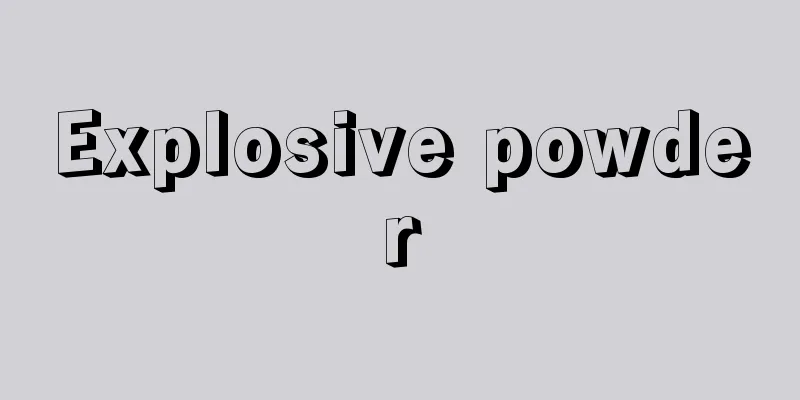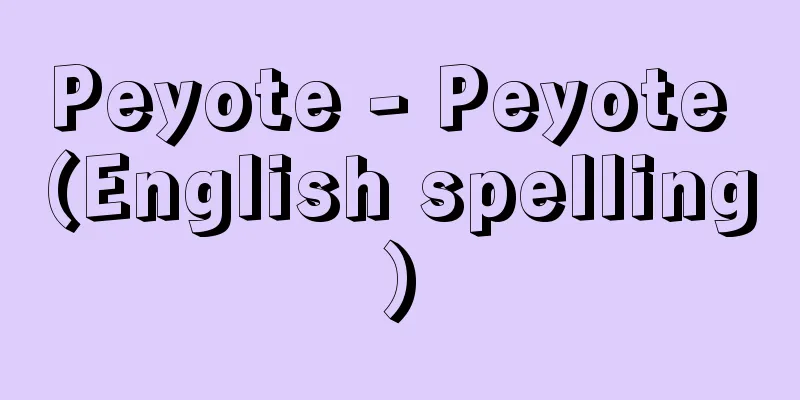Explosive powder

|
Explosive substances that can effectively utilize the energy released during the explosion for industrial or military purposes are collectively called explosives. Explosives refers to explosives in a broad sense, and propellants and propellants in a narrow sense. Explosions of explosives occur when explosives burn rapidly, destroying or scattering objects due to the generation of shock waves and the expansion of the resulting gases. Combustion in which the burning speed is faster than the speed of sound in the medium through which the combustion travels is called detonation to distinguish it from other types of combustion. Combustion in which the burning speed is slower than the speed of sound in explosives is called combustion or deflagration. A detonation produces a shock wave that destroys the surrounding objects, whereas a deflagration produces no shock wave and the thrust is mainly generated by the expansion of the hot gases produced by the combustion. [Tadao Yoshida and Shingo Date] historyAlong with paper, printing, and the compass, gunpowder is considered one of the four great inventions made by the Chinese. There are various theories about the origin of gunpowder. Fire has a long history, but there is debate as to at what stage in the use of fire gunpowder was invented. According to sources, black powder was the main type of explosive until the invention of nitrocellulose, nitroglycerin, and dynamite and smokeless powder that used them in the mid-19th century. Therefore, the appearance of black powder is often considered to be the origin of gunpowder. [Tadao Yoshida and Shingo Date] Before Black PowderBefore the use of black powder, fire weapons thought to be incendiary agents were used. Around 1190 BC, the Trojans are said to have defeated the Greek fleet with an unquenchable fire. Around 500 BC, Chinese Sun Tzu's Art of War used fire attacks. In 249 BC, the Spartans used an incendiary agent made of wood chips, sulfur, and pitch (a semi-solid petroleum component similar to asphalt) in the Battle of Plathena. The most famous incendiary agent of this type in history is Greek fire. The main component of Greek fire was naphtha, to which sulfur and pitch were added. During the Islamic attack on Constantinople in the Eastern Roman Empire from 673 to 678, the architect Kallinikos (who lived around the 7th century) from Heliopolis in Syria revealed the secrets of Greek fire to the Eastern Roman Empire in 678, which caused a great deal of damage to the Islamic fleet. In 718 the Muslims attacked Constantinople again, but were again devastated by Greek Fire. It has long been known that saltpeter, the base of gunpowder, burns in a strange way when placed in a bonfire. A mixture of saltpeter, sulfur and charcoal was first called black powder (a pyrotechnic medicine) in China, and is said to have been invented in the first half of the 7th century by the alchemist Sun Simiao (who made an elixir of immortality). A description of a composition similar to black powder for military use appears in the Wujing Zongyao (1045), compiled by the Northern Song government in China. This book describes the compositions of gunpowder for fireballs, gunpowder for fireballs, and gunpowder for poisonous smoke balls. These were used as explosives, not as propellants. [Tadao Yoshida and Shingo Date] Invention of Black PowderThe composition of black powder that has continued to this day was recorded by Roger Bacon, an English monk, philosopher, and scientist known as the "Wonderful Doctor." He described black powder and saltpeter in detail in his books. At the time, people who made theories that caused fear in society could be put on trial by religious tribunals, and Bacon wrote them down in anagrams. These books were deciphered by Lieutenant Colonel Henry William Lovett Hime (c. 1840-?). Berthold Schwarz (a 14th century German), known as the "Gunpowder Monk," also created black powder based on these books (1313) and used it in artillery. [Tadao Yoshida and Shingo Date] Gunpowder as a firearmSaltpeter came to be used as an ingredient in gunpowder weapons, which came to be used in warfare in China, the Arab world, and Europe. Gunpowder weapons used in China included fire arrows (a type of rocket we now call rockets), projectiles, explosive firearms, and fire cans. One type of explosive firearm, the shintenrai, was used by the Jin army in 1231. Gunpowder was packed into an iron can, which was ignited to explode. The shintenrai was also called the iron bag, and was used by the Yuan army when it landed in Hakata Bay in 1274 (Bun'ei 11). This was the first time that the Japanese, who had never used fire as a means of warfare other than incendiary practices, encountered firearms. However, there is no record of gunpowder being used as a firearm in Japan even after that. [Tadao Yoshida and Shingo Date] JapanIn 1543 (Tenbun 12), a Chinese ship drifted ashore on Tanegashima Island, and the Portuguese passengers were carrying guns. The island's lord, Tanegashima Tokitaka, paid a large sum of money to acquire two guns. Tokitaka learned how to use them himself, and then ordered his page, Sasagawa Koshiro, to learn how to make gunpowder, and had Yaita Kinbei Kiyosada (also known as Kiyosada) research guns. Sasagawa Koshiro learned from the Portuguese how to make black powder, known as the "tsukisifuri-wago method," and that its raw materials are saltpeter, sulfur, and charcoal. Through his efforts, he succeeded in creating black powder as a propellant even more powerful than the gunpowder brought by the Portuguese. Subsequent developments in black powder included the invention of granular powder suitable for use in large artillery, and the use of black powder in mines (1627). [Tadao Yoshida and Shingo Date] ModernEntering the 19th century, Europe saw a succession of inventions and discoveries of new explosives. The explosive fulminate mercury (mercury fulminate) was synthesized in 1800 by Edward Charles Howard (1774-1816) of England. Nitrocellulose, the raw material for smokeless powder, an alternative propellant to black powder, was discovered by Schönbein of Germany in 1845. Furthermore, nitroglycerin, the raw material for dynamite, was discovered in 1846 by Sobrero of Italy. The first inventor of modern explosives was the Swede Nobel. He invented diatomaceous earth dynamite (1866) from nitroglycerin and diatomaceous earth, creating a practical industrial explosive far more powerful than black powder. Prior to this, he invented an industrial detonator that could reliably detonate nitroglycerin and dynamite (1864). He also invented blasting gelatin, the prototype of modern dynamite, in 1875, and ballistite, a double-base smokeless powder, in 1887. Smokeless powder, a high-performance propellant replacing black powder, was invented in 1884 by the Frenchman Paul Vieille (1854-1934) as B powder, named after the Minister of War at the time, Georges Ernest Jean Marie Boulanger (1837-1891), and in 1888, the double-base smokeless powder cordite was invented by the British Frederick Augustus Abel (1827-1902) and J. Dewar. It came to be used mainly as a military explosive, but many compound explosives were invented from the 19th to the 20th century. Among them, picric acid (Shimose powder), TNT (trinitrotoluene), RDX (hexogen), PETN (pentanthrite), HMX (octogen), etc. were used in large quantities as explosives. Nobel's gelatin dynamite was later made cheaper by adding ammonium nitrate and flammable materials, without compromising its performance. In addition, nitroglycerin-free ammonium nitrate explosives and carlits were also made. Since the 1960s, cheap ammonium nitrate oil explosives made only from ammonium nitrate and diesel have appeared, and safer water-containing explosives (slurry explosives and emulsion explosives) have also been developed, establishing their position as the main industrial explosives. Detonators for detonating explosives started out as industrial detonators that ignited explosives with a fuse, but in Japan they have now almost entirely been replaced by electric detonators. However, with the advent of ammonium nitrate oil explosives, the number of accidental detonations with electric detonators has increased, so static-resistant detonators are becoming more common. Furthermore, non-electric detonation methods using fuses have also begun to be used. [Tadao Yoshida and Shingo Date] Definitions and ClassificationsIn Japan, explosives are classified into three types by the Explosives Control Act: gunpowder, explosives, and pyrotechnics, and are defined as follows: Explosives are used for propulsive explosions and are specified by the Explosives Control Act and its Enforcement Regulations (hereinafter referred to as the Act). Explosives are used for destructive explosions and are specified by the Act. Pyrotechnics are products made using gunpowder or explosives and processed to suit a certain purpose and are specified by the Act. [Tadao Yoshida and Shingo Date] Representative explosivesExplosives can be divided into compound explosives and mixed explosives based on their composition. The former are single compounds that can be used as explosives, while the latter are explosives that are a mixture of two or more components. Nitrocellulose is an example of a compound explosive. In the field of explosives, it is called cotton powder, nitrocellulose, cellulose nitrate, etc. It is rarely used alone, but is used as an ingredient in dynamite, propellants, rocket propellants, etc. shows some representative examples of compound explosives. Representative mixed powders include black powder and smokeless powder, which are primarily used as propellants. In addition to black powder and smokeless powder, composite propellants (propellants made by mixing and hardening an oxidizer and a fuel/binder) are also used as rocket propellants. [Tadao Yoshida and Shingo Date] explosiveCompound explosives include nitroglycerin, nitroglycerin, pentane, picric acid, TNT, RDX, HMX, and TATB (triaminotrinitrobenzene). Among explosives, those that explode easily are called primary explosives. Compound primary explosives include mercury, lead azide, DDNP (diazodinitrophenol), lead trinitroresorcinol, and tetracene. Most of the commercially available explosives are mixtures. Ammonium nitrate oil explosives, dynamite, and water-based explosives are the main mixtures currently used for rock blasting. TNT, PETN, RDX, and CE (tetryl) are typical military explosives, but to compensate for the shortcomings of these compound explosives, mixed explosives such as those shown in are used in the military. [Tadao Yoshida and Shingo Date] PyrotechnicsA general term for things that are made using gunpowder or explosives and processed and shaped to suit a certain purpose. There are many different types and purposes for which fireworks can be used, but fireworks are a typical example. [Tadao Yoshida and Shingo Date] Laws and regulations related to explosivesExplosives are dangerous materials and are subject to various restrictions under several laws. The core law is the Explosives Control Law (Law No. 149 of 1950), which aims to prevent disasters caused by explosives and ensure public safety by regulating the manufacture, sale, storage, transportation, consumption and other handling of explosives. The Explosives Control Law requires that the manufacture, sale, and storage of explosives require permission from the Minister of Economy, Trade and Industry or the prefectural governor, and that one must own an explosives magazine. Any changes to manufacturing methods or manufacturing facilities also require permission. In addition, manufacturing and storage must appoint a safety officer with certain qualifications. The transfer, consumption, disposal, and import of explosives require permission from the prefectural governor, and transportation must be reported to the Public Safety Commission and a transportation certificate issued. In addition, many detailed safety regulations are set out, such as the structure of explosives magazines and the methods of igniting and detonating explosives, and any violation of any of these will be severely punished, even if no accident occurs. Other relevant laws and regulations include the Explosives Control Law Enforcement Order and Enforcement Regulations for manufacturing, the Explosives Transportation Regulations and Cabinet Office Ordinance on the Transport of Explosives for transportation, and the Mine Safety Law for use. [Tadao Yoshida and Shingo Date] Explosives performance and testing methodsThe performance of explosives is as follows, and these performances must be satisfied depending on the purpose of use. Here, sensitivity is a measure of how easily an explosive will explode or ignite when exposed to external stimuli such as heat or impact. shows the performance of various explosives. (1) Explosive power There is dynamic power and static power. The former is expressed by the detonation velocity, which is closely related to the destructive action, and the latter is expressed by the expansive force of the explosive gases that push out the broken rocks and other debris. Test methods for explosive power include detonation velocity measurement, which measures dynamic power, and ferocity test, while the Trauzer lead mortar test, which measures static power, and ballistic pendulum test are used. (2) Impact Sensitivity Explosives are detonated by detonators or boosters. Impact sensitivity indicates how easily an explosive can detonate. It is necessary for explosives to be detonated reliably, but if the detonation sensitivity is too high, there is a risk of an explosion during normal handling. Ammonium nitrate oil explosives are considered relatively safe explosives, but one of the conditions is that they cannot be detonated by a single No. 6 detonator, as stipulated by law. The card gap test is used as a scientific method for measuring shock sensitivity. A standard explosive called an inducer is detonated, and the resulting shock wave is passed through an acrylic card to weaken it and projected onto the explosive to be tested (received explosive) to determine the strength of the shock wave that will cause the recipient explosive to explode. A practical test method is the sympathetic detonation test on sand. Two cartridges are placed on the sand, one is detonated, and the maximum distance at which the explosion can be transmitted (sympathetic detonation) is determined. Usually, holes (blast holes) are drilled in rock, several cartridges are loaded into them, and one end is detonated to detonate the blast. Sometimes rock powder or other materials get between the cartridges, creating gaps, but even in such cases, sympathetic detonation is necessary. Sensitizers are sometimes used to improve the impact sensitivity of industrial explosives, and the inclusion of air bubbles in water-containing explosives is also used to improve their detonation performance. (3) After-gas Explosives are sometimes used inside tunnels. In this case, if the gas (after-gas) produced as a result of blasting is highly toxic, it will be impossible to enter the site for a long time after blasting. For this reason, it is desirable for the after-gas to be as toxic as possible. Known toxic components of after-gas include hydrogen chloride, sulfurous acid gas (sulfur dioxide), carbon monoxide, and nitrogen dioxide. The first two can be prevented by not using explosives that contain chlorine or sulfur, and the production of the latter two can be reduced by selecting an explosive composition that has an oxygen balance of 0 (zero). For explosives consisting of carbon, hydrogen, oxygen, and nitrogen, oxygen equilibrium is zero when the calculated products when the explosive explodes are only nitrogen, water, and carbon dioxide. Compound explosives with oxygen equilibrium of zero include nitroglycerol, and mixed explosives include ammonium nitrate oil explosives. Explosive power is also greatest when oxygen equilibrium is zero. (4) Non-ignitability of methane gas and coal dust When blasting is performed inside a coal mine, methane gas or coal dust may ignite, causing an explosion inside the mine. For this reason, certified explosives that do not pose such a risk are used for blasting inside coal mines. Many certified explosives contain heat reducing and flame retardants that lower the temperature of the explosive gas and make the gas less likely to ignite. Tests are conducted to determine the ease of ignition and the rate of combustion. Dynamite, ammonium nitrate oil explosives, and water-based explosives currently in use are non-ignitable at room temperature. RDX, HMX, and tetryl can be ignited and burned with 1 gram of ignition agent. (5) Stability The thermal stability of explosives is also an important property from the viewpoint of safety. Explosives containing nitrocellulose and nitroglycerin have relatively low thermal stability, and the Explosives Control Law requires that they be subject to particularly strict inspections. This is because nitrate esters such as nitrocellulose and nitroglycerin can spontaneously ignite or explode if stored for a long period of time. (6) Sensitivity Tests Explosives may ignite or explode when struck, collided, or rubbed against something. For safety reasons, it is desirable for ordinary explosives not to ignite when subjected to such mechanical stimuli. To examine these properties, drop hammer sensitivity tests and friction sensitivity tests are conducted. In the former, an iron weight is dropped onto an explosive placed between cylinders to determine from how many centimeters it must be dropped to ignite or explode. In the latter case, the BAM friction sensitivity test is currently used widely around the world, in which an explosive is placed on a rough-surfaced magnetic plate, a pestle made of the same material is pressed against it, and the magnetic plate underneath is moved at a constant speed. Friction sensitivity is expressed as the pressing force at which ignition or explosion occurs. [Tadao Yoshida and Shingo Date] Performance of propellants and rocket propellantsThe most important performance factors are specific impulse, burning rate, and the relationship between burning rate and pressure, as well as safety performance. Specific impulse is the thrust per unit weight of rocket propellant, and is expressed by the symbol Isp (units per second). The Isp of black powder, smokeless powder, and composite propellant is known to be approximately 60 to 150 seconds (for black powder used in fireworks), approximately 210 to 240 seconds, and approximately 240 to 265 seconds, respectively. Generally, the higher the pressure, the faster the burning rate of the propellant. Also, the larger the surface area, the faster the burning rate. By selecting these shapes, the desired burning rate and pressure can be obtained. [Tadao Yoshida and Shingo Date] Uses of explosivesThe largest use of industrial explosives is for blasting. Tunnels are excavated, mineral resources are extracted from underground mines, and underground power plants are constructed using tunnel excavation thrust blasting. Explosives with good after-gas generation are used in such mines. Limestone and stone mining is usually done on the exposed surface, but here a blasting method called the bench cut method is used. Unlike in mines, the after-gas generated disperses quickly and there is no need to worry, so inexpensive ammonium nitrate oil explosives are often used. Large rocks resulting from blasting or cliff collapses can be broken into smaller pieces by small-piece blasting. The method of blasting soil using explosives for land development, road construction, land reclamation, etc. is called earth blasting. In snowy areas, avalanche blasting is also sometimes used to artificially create avalanches before they occur in early spring. Underwater blasting is the act of exploding underwater to remove obstacles such as reefs in harbors, straits, rivers, and lakes to make it easier for large ships to navigate, to blow up and cut up sunken ships, to create fish reefs, to blow up ice at sea, to conduct seismic exploration, and to explosively mold metal plates. In addition, when blasting is carried out in cities, such as when demolishing buildings and bridges, it is desirable to have less debris and less noise from the explosion, so concrete crushers suitable for this purpose have been developed and are on sale. The first explosive demolition attempt in Japan was made at the United Nations Peace Museum at the International Science and Technology Exposition in 1986, but there are few examples of this happening in Japan. There has also been an increase in jobs using explosives to cut, drill holes, press, and mold objects. Many pyrotechnic devices with various functions are used in space rockets. Gunpowder's thrust is used as the propellant that launches bullets and shells at high speeds, and as the propellant that launches rockets. When the propellant is loaded into the chamber of a gun, it is called a charge. The combustion of the charge, pressure changes, and bullet velocity are all considered in internal ballistics, while the behavior of the bullet after it leaves the muzzle is considered in external ballistics. The behavior of a bullet after it hits its target is the subject of penetration ballistics. Propellants are primarily used for military purposes, but they also have peaceful uses, such as: A construction nail gun is a device that shoots nails out of a gun and drives them into concrete. A lifeline projector is used in ship salvage. In addition to military rockets and space rockets, propellants are also used in many practical applications, such as catenary rockets used by electric power companies for overhead lines in mountainous areas, lifeline rockets for sea rescue, signal rockets for sea rescue, weather observation rockets, and rain rockets. [Tadao Yoshida and Shingo Date] Explosives IndustryThe industry that manufactures explosives is called the explosives industry. The first explosives industry was a black powder manufacturing industry, but after Nobel's invention of dynamite, dynamite production became the focus of the explosives industry. Later, carlit and ammonium nitrate explosives were added, but since the 1960s, ammonium nitrate oil explosives have accounted for the majority of industrial explosives in terms of volume. Furthermore, for safety reasons, water-containing explosives have appeared as an alternative explosive to dynamite, and their production is increasing. With the advent of dynamite, the explosives industry became a highly profitable business. Many companies around the world started out as explosives manufacturers and have since developed into comprehensive chemical companies. Typical examples include DuPont in the United States and ICI (now Akzo Nobel) in the United Kingdom. However, in modern times, the emergence of ammonium nitrate oil explosives and other products has caused the high profitability to disappear, and the proportion of explosives in these companies' sales has become very small. Japan's explosives industry began after the Meiji period. From the Meiji to Taisho periods, the manufacture of industrial explosives was carried out at military arsenals, while large quantities were imported. When the import of explosives came to a halt during World War I, momentum for domestic production of industrial explosives increased, and in 1917 (Taisho 6) Nippon Kayaku's Asa Factory was established, in 1919 Nippon Carlit's Hodogaya Factory and Nippon Oil & Fats' Taketoyo Factory, and in 1930 (Showa 5) Asahi Kasei's Nobeoka Factory were established. Other companies that manufactured explosives included Nippon Koki, Chugoku Kayaku, Kayaku Japan, Radieh Kogyo, NOF Corp., Daicel, Nippon Anho Explosives Manufacturing, Nippon Carlit, and Shikoku Anho. [Tadao Yoshida and Shingo Date] "Nakahara Shoji, 'An Introduction to Explosives Science' (1983, Sangyo Tosho)" ▽ "Explosives Society of Japan, edited and published, 'Explosives Society of Japan Standard VI Explosives Glossary' (1999)" ▽ "Nakahara Shoji, 'Seven Mysteries of Explosives - A Stroll through the History of Explosives' (2000, self-published)" ▽ "Sasa Koichi, 'Explosives Engineering' (2001, Morikita Publishing)" ▽ "Explosives Society of Japan, edited, 'Explosives Analysis Handbook' (2002, Maruzen)" ▽ "Ballistics Research Group, edited, 'Firearms and Ammunition Technology Handbook' revised edition (2003, Defense Technology Association)" ▽ "Japan Explosives Manufacturers Association, data editorial department, edited, 'Explosives Control Laws and Regulations Commentary' 2003 revised edition (2004, Japan Explosives Manufacturers Association)" ▽ "Handbook of Energetic Materials, 2nd Edition (2010, Kyoritsu Shuppan)" edited by the Japan Explosives Society and supervised by Shozo Tamura [References] | | | | | | | | | | | | | | | | | | | | | | | | | | |©Shogakukan "> Representative examples of compound explosives (Table 1) ©Shogakukan "> Major mixed explosives (military use) [Table 2] ©Shogakukan "> Performance of various explosives (Table 3) ©Shogakukan "> Maximum storage capacity of powder magazine ©Shogakukan "> Safety distance for maximum storage capacity of powder magazine Source: Shogakukan Encyclopedia Nipponica About Encyclopedia Nipponica Information | Legend |
|
爆発性物質で、爆発の際に発生するエネルギーを、工業用や軍用などに有効に利用できるものを火薬類と総称する。火薬とは広義には火薬類、狭義には発射薬や推進薬をさす。 火薬類の爆発は、火薬類の急速な燃焼によっておこり、衝撃波の発生や生成ガスの膨張により、物体を破壊したり飛ばしたりする。燃焼速度が燃焼の伝える媒質中の音速より速い燃焼は、爆轟(ばくごう)(デトネーションdetonation)とよんで区別する。火薬類の音速以下の燃焼は、燃焼(コンバスチョンcombustion)または爆燃(デフラグレーションdeflagration)とよばれる。 爆轟が生ずると周囲に衝撃波が放射され、その作用によって周囲のものが破壊される。一方、爆燃では衝撃波は発生せず、主として燃焼で生成した高温ガスの膨張によって推進力が生ずる。 [吉田忠雄・伊達新吾] 歴史紙、印刷、羅針盤とともに、中国人の四大発明の一つとされる。火薬の起源については諸説がある。火の歴史は古いが、火の利用のどの段階をもって火薬の発明というかは、議論の分かれるところである。資料による限りでは、19世紀中ごろのニトロセルロース、ニトログリセリンおよびそれらを用いたダイナマイト、無煙火薬の発明までは、主要な火薬類は黒色火薬であった。したがって、黒色火薬の登場を火薬の起源とする場合が多い。 [吉田忠雄・伊達新吾] 黒色火薬以前黒色火薬が使われるようになる前に、焼夷剤(しょういざい)とみられる火器が使われている。紀元前1190年ごろには、トロイ人は消えない火でギリシア船隊を破ったといわれる。前500年ごろの中国の孫子の兵法には火攻(かこう)が使われている。前249年には、スパルタ人がプラテナの戦いで、木片、硫黄(いおう)、ピッチ(アスファルトのような半固体の石油成分)からなる焼夷剤を使っている。この種の焼夷剤で史上有名なのはギリシア火である。ギリシア火の主成分はナフサで、これに硫黄とピッチが加えられたものであった。673~678年、イスラムが東ローマ帝国のコンスタンティノープルを攻撃した際に、シリアのヘリオポリスからきた建築家カリニコスKallinikos(7世紀ころの人物)が、678年にギリシア火の秘密を東ローマ帝国に教え、これによりイスラムの艦隊は大打撃を受けた。718年にもイスラムがコンスタンティノープルをふたたび攻撃したが、同じくギリシア火により大打撃を被った。 火薬の基礎となる硝石が、焚火(たきび)の中に入ると奇妙な燃え方をすることは古くから知られていた。硝石、硫黄および木炭の混合物は、中国では最初、黒火薬(発火性医薬品)とよばれ、煉丹(れんたん)術師(不老長寿の薬をつくる)の孫思邈(そんしばく)によって7世紀前半に発明されたといわれている。軍用としての黒色火薬類似の配合組成の記述は、中国の北宋(ほくそう)政府編集の『武経総要』(1045)に現れている。この書には、火毬(かきゅう)用火薬、蒺藜(しつれい)火毬用火薬および毒薬煙毬用火薬などの配合組成が記されている。これらは発射薬としてではなくて炸薬(さくやく)として用いられた。 [吉田忠雄・伊達新吾] 黒色火薬の発明現在まで続いた黒色火薬の組成は「驚異博士」とよばれたイギリスの僧侶(そうりょ)であり哲学者、科学者のロジャー・ベーコンによって記録されている。彼はその著書のなかで、黒色火薬と硝石のことを詳しく述べている。当時、社会に不安を与える説をなす者は宗教裁判にかけられることがあり、彼は「字なぞ」(アナグラム)で記した。これらの著作はハイムHenry William Lovett Hime(1840ころ―?)中佐によって解読された。また「火薬修道士」とよばれたドイツのベルトルド・シュバルツBerthold Schwarz(14世紀の人物)もこの書を基にして黒色火薬をつくり(1313)、火砲に用いている。 [吉田忠雄・伊達新吾] 火器としての火薬硝石が火薬兵器の成分として使われるようになり、中国、アラブ、ヨーロッパで戦争に用いられるようになった。中国で使われた火薬兵器としては、火箭(かせん)(いまでいうロケットの一種)、投射火器、爆裂(ばくれつ)火器、火缶(かかん)などがあった。爆裂火器のなかの震天雷(しんてんらい)は、1231年に金(きん)の軍隊によって用いられた。鉄缶に火薬を詰め、これに点火して爆裂させたものである。震天雷は鉄包ともよばれ、1274年(文永11)元(げん)軍が博多(はかた)湾に上陸した際にも用いられた。これは、焼打ち以外に火を戦争手段として用いなかった日本人にとって、火器に出会った初めての経験であった。しかし、その後も日本では火薬を火器として使ったという記録はない。 [吉田忠雄・伊達新吾] 日本1543年(天文12)種子島(たねがしま)に1隻の中国船が漂着し、乗り合わせていたポルトガル人が鉄砲をもっていた。島主の種子島時堯(ときたか)は大金を積んで2挺(ちょう)の鉄砲を譲り受けた。時堯自身その使用法を学び、さらに小姓篠川小四郎(ささがわこじろう)に命じて火薬の製法を学ばせ、八板金兵衛清定(清貞とも)に鉄砲を研究させた。篠川小四郎は、ポルトガル人より「搗篩(つきふるい)・和合の法」とよばれる黒色火薬の製造法と、その原料が硝石、硫黄および木炭であることを習った。彼はその努力によって、ポルトガル人がもたらした火薬よりさらに強力な発射薬としての黒色火薬をつくることに成功した。 黒色火薬のその後の進歩は、大型火砲に使えるような粒状火薬の発明や、黒色火薬の鉱山での使用(1627)であった。 [吉田忠雄・伊達新吾] 近代19世紀に入ると、ヨーロッパにおいては新しい火薬類の発明、発見が相次いだ。起爆薬の雷汞(らいこう)(雷酸水銀)は、1800年イギリスのハワードEdward Charles Howard(1774―1816)によって合成された。黒色火薬にかわる発射薬である無煙火薬の原料となるニトロセルロースは、1845年ドイツのシェーンバインによって発見された。さらにダイナマイトの原料となるニトログリセリンは、1846年イタリアのソブレロによって発見されている。 近代的な火薬類の発明第一人者はスウェーデンのノーベルである。彼はニトログリセリンと珪藻土(けいそうど)から、珪藻土ダイナマイトを発明(1866)し、黒色火薬よりはるかに威力のある実用的工業爆薬を世に出した。なお、それに先駆けて、ニトログリセリンやダイナマイトを確実に爆発させられる工業雷管を発明している(1864)。彼はさらに、現在のダイナマイトの原型であるブラスチングゼラチンを1875年に、また1887年には、ダブルベース無煙火薬バリスタイトを発明している。 黒色火薬にかわる高性能の発射薬である無煙火薬は、同じころフランスのビエイユPaul Vieille(1854―1934)によって、当時の陸軍大臣ブーランジェGeorges Ernest Jean Marie Boulanger(1837―1891)の名をとったB火薬として1884年に発明され、1888年にはイギリスのアーベルFrederick Augustus Abel(1827―1902)とJ・デュワーによってダブルベース無煙火薬コルダイトが発明された。主として軍用爆薬として使われるようになったが、多くの化合火薬類が19世紀から20世紀にかけて発明された。そのなかで炸薬としては、ピクリン酸(下瀬(しもせ)火薬)、TNT(トリニトロトルエン)、RDX(ヘキソーゲン)、PETN(ペンスリット)、HMX(オクトーゲン)などが大量に使われてきた。 ノーベルの膠質(こうしつ)ダイナマイトはその後、硝酸アンモニウム(硝安)や可燃物を加えて、より安く、性能を低下させないものがつくられるようになった。また、ニトログリセリンを含まない硝安爆薬やカーリットもつくられた。1960年代以降、硝安と軽油だけからつくられる安価な硝安油剤爆薬が登場し、また安全性の高い含水爆薬(スラリー爆薬およびエマルション爆薬)も開発され、主要な工業爆薬としての立場を築いている。 爆薬を起爆するための雷管は、導火線で点火する工業雷管に始まったが、日本国内では現在、電気雷管にほぼ移行している。しかし硝安油剤爆薬の登場により電気雷管の暴発事故が増したために、耐静電気雷管が普及しつつある。さらに、導火管を用いた、電気を使わない起爆方法も運用が始まっている。 [吉田忠雄・伊達新吾] 定義と分類火薬類は日本では、火薬類取締法令によって火薬、爆薬、火工品の3種に分類され、次のように定義される。火薬とは、推進的爆発の用途に供せられるものであって、火薬類取締法および同法施行規則(以下法令という)で定めるもの。爆薬とは、破壊的爆発の用途に供せられるものであって、法令で定めるもの。火工品とは、火薬、爆薬を使用して、ある目的に適するように加工したものであって、法令で定めるものをいう。 [吉田忠雄・伊達新吾] 代表的火薬類火薬類は、組成によって化合火薬類と混合火薬類に分けることができる。前者は単一の化合物で火薬類としての用途をもつものであり、後者は2種以上の成分を混合した火薬類である。 化合火薬としてはニトロセルロースがある。火薬の方面では綿薬、硝化綿、硝酸繊維素などとよばれ、単独で使われることは少なく、ダイナマイト、発射薬、ロケット推進薬などの成分として使われる。に化合火薬の代表例を示した。 混合火薬の代表的なものには黒色火薬、無煙火薬があり、おもに発射薬として使われている。ロケット推進薬としては、黒色火薬や無煙火薬のほかにコンポジット推進薬(酸化剤と燃料兼バインダー=粘結剤を混合・硬化させた推進薬)が使われている。 [吉田忠雄・伊達新吾] 爆薬化合爆薬としてはニトログリセリン、ニトログリコール、ペンスリット、ピクリン酸、TNT、RDX、HMX、TATB(トリアミノトリニトロベンゼン)などがある。 爆薬のなかでとくに容易に爆発しやすいものは起爆薬とよばれている。化合起爆薬としては雷汞、アジ化鉛、DDNP(ジアゾジニトロフェノール)、トリニトロレゾルシン鉛、テトラセンなどがある。 工業化されている爆薬の多くは混合爆薬である。硝安油剤爆薬、ダイナマイトおよび含水爆薬が、岩石の爆破(発破(はっぱ)という)に現在用いられている主要混合爆薬である。 TNT、PETN、RDX、CE(テトリル)は代表的な軍用爆薬でもあるが、これらの化合爆薬の欠点を補うために、のような混合爆薬が軍用に使われている。 [吉田忠雄・伊達新吾] 火工品火薬、爆薬を使用して、ある目的に適するように加工、成形したものの総称。その目的は多様で種類も多いが、花火はその代表的なものである。 [吉田忠雄・伊達新吾] 火薬類の関係法規火薬類は危険物であり、いくつかの法律によって種々の制限が設けられている。その中心法規は火薬類取締法(昭和25年法律第149号)で、火薬類の製造、販売、貯蔵、運搬、消費その他の取扱いを規制することにより、火薬類による災害を防止し、公共の安全を確保することを目的としている。 火薬類取締法によって、火薬類の製造、販売、貯蔵は、経済産業大臣または都道府県知事の許可と、火薬庫所有が義務づけられており、製造方法、製造施設の変更も許可を得なければならない。また、製造、貯蔵には一定の資格をもった保安責任者を設置しなければならない。火薬類の譲渡、消費、廃棄、輸入は都道府県知事の許可が必要であるし、運搬も公安委員会に届け出て運搬証明の交付を受ける。このほか、火薬庫の構造、火薬類の点火、点爆の方法など、多くの細かい保安上の規則が定められ、たとえ事故が起こらなくても、これらのうちどれかに違反することがあれば厳しく罰せられる。 ほかに製造に関しては火薬類取締法施行令、同法施行規則、運搬には火薬類運送規則、火薬類の運搬に関する内閣府令など、使用には鉱山保安法などの関係法規がある。 [吉田忠雄・伊達新吾] 火薬類の性能と試験法爆薬の性能としては次に述べるようなものがあり、使用目的に応じてこれらの性能が満足されなければならない。ここで、感度とは、外から熱や衝撃などの刺激が加わったときに、どのくらい容易に爆発、発火しやすいかを示す尺度である。に各種火薬類の性能を示す。 (1)爆発威力 動的威力と静的威力とがある。前者は、破壊的作用と関係の深い爆轟速度で表され、後者は、破壊的作用で壊れた岩石などを押し出す爆発ガスの膨張力で表される。 爆発威力の試験法としては、動的威力を測定する爆速測定、猛度試験、静的威力を測定するトラウズル鉛壔(えんとう)試験、弾動臼砲(きゅうほう)試験、弾動振子試験などがある。 (2)衝撃起爆感度 爆薬は雷管や伝爆薬(ブースター)によって起爆される。この起爆されやすさを表すのが衝撃起爆感度である。爆薬は確実に起爆されることが必要であるが、起爆感度が高すぎると、平常の取扱い中に爆発する危険が生じる。硝安油剤爆薬は比較的安全な爆薬として扱われているが、その条件の一つとして6号雷管1本では起爆できないことが法令で定められている。 衝撃起爆感度を科学的に測定する方法として、カードギャップ試験が使われている。励爆薬という標準爆薬を爆発させ、発生した衝撃波をアクリル樹脂製カードを通過させて弱めて、試験しようとする爆薬(受爆薬)に投射し、どの強さの衝撃波で受爆薬が爆発するかを調べる。実用的な試験法としては、砂上殉爆試験がある。2本の薬包を砂の上に並べて、一方を爆発させ、最大でどのくらい離れても爆発が伝わる(殉爆する)かを調べる方法である。普通、岩石に孔(あな)(発破孔)をあけ、その中に爆薬包を何本か装薬して、一端から起爆して発破が行われる。ときには薬包の間に岩石粉などが入り込んで、すきまができることがあるが、このような場合でも殉爆することが必要である。 工業爆薬の衝撃起爆感度を向上させるために鋭感剤が用いられることもある。また、起爆性能を向上させるために気泡を封入する方法も含水爆薬で用いられている。 (3)あとガス(後ガス) 爆薬はトンネル(坑)内で使用されることがある。この場合には、発破の結果生じたガス(後ガス)の毒性が強いと、発破後の現場に長時間入れなくなる。このために、後ガスの毒性の少ないことが望まれる。後ガスの毒性成分としては、塩化水素、亜硫酸ガス(二酸化硫黄)、一酸化炭素、二酸化窒素などが知られている。前二者は、塩素や硫黄を含む爆薬を使用しないことで出さなくすることができ、後二者は、爆薬の組成を、酸素バランスが0(ゼロ)となるように選ぶことによって、生成を少なくすることができる。 炭素、水素、酸素および窒素からなる爆薬については、酸素平衡0とは、爆薬が爆発したときの計算上の生成物が、窒素、水、炭酸ガスだけであるような場合である。酸素平衡0の化合爆薬には、ニトログリコール、混合爆薬には硝安油剤爆薬がある。爆発威力も酸素平衡0の場合がもっとも大きい。 (4)メタンガスや炭塵(たんじん)への非着火性 石炭鉱山の坑内で発破を行うと、メタンガスや炭塵に着火して坑内爆発をおこすことがある。そのために、炭鉱内の発破では、それらのおそれのない検定爆薬が使用される。検定爆薬には、爆発ガスの温度を下げたり、ガスへ着火しにくくしたりする減熱消炎剤が入っているものが多い。 着火の容易さや燃焼の速さを調べる試験が行われる。現在使われているダイナマイト、硝安油剤爆薬、含水爆薬は常温では非着火性である。RDX、HMXおよびテトリルは1グラムの着火剤で着火して燃焼する。 (5)安定性 爆薬の熱安定性も保安上重要な性質である。ニトロセルロースやニトログリセリンを含む爆薬は、比較的に熱安定性が低いので、火薬類取締法ではとくに検査を厳重に行うように指示している。これはニトロセルロースやニトログリセリンのような硝酸エステル類は、長時間貯蔵すると自然発火や自然爆発をおこすからである。 (6)感度試験 爆薬はたたいたり衝突したりこすったりすると発火、爆発することがある。普通の爆薬はそのような機械的刺激によって発火しないことが保安上望ましい。このような性質を調べるために落槌(らくつい)感度試験、摩擦感度試験が行われる。前者は、鉄のおもりを円柱の間に挟んだ爆薬の上に落として、何センチメートルの高さから落としたら発火、爆発するかを調べるものである。後者の場合、現在世界的に広く使われているのはBAM摩擦感度試験で、表面のざらざらした磁性板の上に爆薬を置き、同じ材料でできた杵(きね)を押し付け、下の磁性板を一定速度で動かす。発火、爆発のおこる押し付け力で摩擦感度を表す。 [吉田忠雄・伊達新吾] 発射薬・ロケット推進薬の性能もっとも重要な性能は比推力、燃焼速度、燃焼速度と圧力の関係などであり、このほかに安全性能が加わる。比推力はロケット推進薬の単位重量当りの推力で、Isp(単位秒)の記号で表される。黒色火薬、無煙火薬、コンポジット推進薬のIspは、それぞれ約60~150秒(打上げ花火用黒色火薬の場合)、約210~240秒、約240~265秒が知られている。 発射薬や推進薬の燃焼速度は、一般に圧力が高いほど速くなる。また、表面積が大きいほど燃焼速度も大きい。これらの形状を選ぶことによって希望の燃焼速度や圧力が得られる。 [吉田忠雄・伊達新吾] 火薬類の用途産業爆薬の最大の用途は発破用である。トンネルを掘ったり、鉱物資源を坑内で採掘したり、地下発電所の建設などは坑道掘推発破により行われる。このような坑内では後ガスのよい爆薬が使用される。石灰石や石材の採掘は通常露出した地表で行われるが、ここではベンチカット法という発破法が実施される。坑内と異なり、発生した後ガスもすぐに拡散し心配がないので、安価な硝安油剤爆薬が多く用いられる。 発破や崖(がけ)崩れで生じた大きな石は小割(こわり)発破で小さくすることができる。土地造成、道路整備、開墾などのために火薬類を用いて土の部分を発破する方法は土(つち)発破とよばれている。積雪地帯においては春先に雪崩(なだれ)がおこる前に人工的に雪崩をおこさせる雪崩発破も行われることがある。 大型船の航行を容易にするために、港湾、海峡、河川、湖沼中の岩礁などの障害物を取り除いたり、沈没船を爆破切断したり、魚礁をつくったり、洋上の氷を爆破したり、地震探査を試みたり、金属板の爆発成形をしたりするために、水中で爆発を行わせることを水中発破という。また、建物や橋の解体など都市内で行う発破の場合には、飛散物が少なく爆発騒音も小さいことが望まれるため、これに適したコンクリート破砕器が開発され販売されている。日本初の爆発解体は1986年(昭和61)に国際科学技術博覧会の国際連合平和館で試みられたが、国内での事例は少ない。 爆薬を用いて物を切断したり、孔をあけたり、圧接したり、成型したりする仕事も増えてきた。宇宙ロケットにはいろいろな機能をもった火工品が多数使われている。 火薬の推進力は、弾丸や砲弾を高速で発射する発射薬や、ロケットを飛ばす推進薬として使われている。発射薬を銃砲の薬室内に装填(そうてん)したときは装薬とよばれる。装薬の燃焼、圧力変化および弾丸の速度などは内部弾道学で扱われ、弾丸が砲口を出てからのようすは外部弾道学で扱われる。 弾丸が目的物に命中してからのふるまいは侵徹弾道学で扱われる。発射薬は主として軍用に使われるが、次のような平和利用もある。建設用鋲打(びょううち)銃は銃から鋲を打ち出して、コンクリートに打ち込む装置である。救命索投射銃は船舶の救難に使われる。 推進薬は軍用ロケット、宇宙ロケットなどのほかに、電力会社が山岳地帯での架線に利用する架線用放射ロケット、海難救助用の救命索ロケット、海難救助用信号ロケット、気象観測ロケット、降雨ロケットなど、実用化されているものも多い。 [吉田忠雄・伊達新吾] 火薬工業火薬類を製造する工業を火薬工業とよぶ。最初の火薬工業は、黒色火薬製造業であったが、ノーベルのダイナマイトの発明を経て、ダイナマイト製造が火薬工業の中心となった。その後、カーリットや硝安爆薬も加わったが、1960年代以降は硝安油剤爆薬が量的には産業爆薬の過半量を占めるようになっている。さらに、安全性の面から含水爆薬がダイナマイトにかわりうる爆薬として登場し、その生産量を増している。 ダイナマイトの登場により、火薬工業は高収益の業種となった。そして世界では火薬工業から出発して、総合化学会社に発展したものが多い。アメリカのデュポン社、イギリスのICI社(現、アクゾノーベル)などはその典型的な例である。しかしながら現代では、硝安油剤爆薬などの出現によって高収益性が失われ、それらの会社のなかで火薬類の売上比率は非常に少なくなっている。 日本で火薬工業が始まったのは明治以降である。明治から大正にかけては、産業用火薬類の製造は、軍の工廠(こうしょう)で行われ、一方では大量の輸入が行われていた。第一次世界大戦で火薬類の輸入が止まったことを契機として、産業爆薬国産の機運が高まり、1917年(大正6)に日本化薬・厚狭(あさ)工場、1919年に日本カーリット・保土ケ谷工場および日本油脂・武豊(たけとよ)工場、1930年(昭和5)に旭化成・延岡工場ができた。そのほか、日本工機、中国化薬、カヤク・ジャパン、ラジエ工業、日油、ダイセル、日本アンホ火薬製造、日本カーリット、四国アンホなどが火薬類を製造している。 [吉田忠雄・伊達新吾] 『中原正二著『火薬学概論』(1983・産業図書)』▽『火薬学会編・刊『火薬学会規格Ⅵ 火薬用語集』(1999)』▽『中原正二著『火薬七つの謎――火薬史漫歩』(2000・自費出版)』▽『佐々宏一著『火薬工学』(2001・森北出版)』▽『火薬学会編『火薬分析ハンドブック』(2002・丸善)』▽『弾道学研究会編『火器弾薬技術ハンドブック』改訂版(2003・防衛技術協会)』▽『経済産業省資源エネルギー庁原子力安全・保安院保安課監修、日本火薬工業会資料編集部編『火薬類取締法令の解説』平成15年改訂版(2004・日本火薬工業会)』▽『火薬学会編、田村昌三監修『エネルギー物質ハンドブック』第2版(2010・共立出版)』 [参照項目] | | | | | | | | | | | | | | | | | | | | | | | | | | |©Shogakukan"> 化合火薬の代表例〔表1〕 ©Shogakukan"> おもな混合爆薬(軍用)〔表2〕 ©Shogakukan"> 各種火薬類の性能〔表3〕 ©Shogakukan"> 火薬庫の最大貯蔵量 ©Shogakukan"> 火薬庫の最大貯蔵量に対する保安距離 出典 小学館 日本大百科全書(ニッポニカ)日本大百科全書(ニッポニカ)について 情報 | 凡例 |
<<: Kayakuguri (Japanese accentor)
Recommend
Apartment
〘 noun 〙 (appartement) = apartment house ※Paris Fe...
Dhu Nuwas (English spelling)
...The great flood described in the Quran, Chapte...
Asthenopia (Eye strain)
What is the disease? Continuous use of the eyes, ...
Omi Gakuen - Oumi Gakuen
…He worked at the Shiga Prefectural Government fr...
Ectocarpus
A genus of the family Phaeophyceae in the order Ph...
Kigusuri
…The term “herbal medicine” first appeared in 188...
Akiba faith - Akiba Shinko
This is a belief related to the deity enshrined a...
Juana (English spelling)
1479‐1555 Juana la loca, popularly known as the Ma...
DSL - Digital Subscriber Line
A technology that enables high-speed communicatio...
Embiotocidae
...Late spring, when the fish are pregnant, is co...
Touseki
A great thief in ancient China. Lu reactor He is s...
Gerbertus
…Gerbertus, Latin name. French clergyman and educ...
The Road to Space Flight
…Although his research was not recognized as fant...
Basarabia
…the former name of the region of the present Rep...
Turnaround line - Return line
…There are two main uses. One is used in general ...







![Shizukuishi [town] - Shizukuishi](/upload/images/67cbc1c4aad52.webp)

